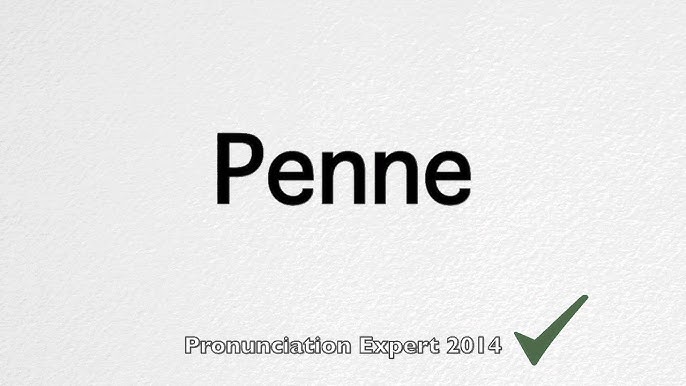Have you ever wondered how to say “penne” correctly? This beloved tube-shaped pasta is a staple in kitchens around the world, but its pronunciation can be a mystery for those unfamiliar with Italian. Fear not, pasta enthusiasts! This guide will walk you through the secrets of mastering How to Say Penne with authentic Italian flair.
Why Pronunciation Matters?
Perfecting Italian pasta pronunciation goes beyond simply getting the right word. It’s a sign of respect for the Italian language and culture. Imagine the satisfaction of ordering your penne arrabbiata flawlessly or discussing the merits of gnocchi with newfound fluency. Pronunciation becomes a bridge to a deeper understanding and enjoyment of Italian cuisine.
Common Mispronunciations and How to Avoid Them
Many pasta names can trip up the uninitiated. Here are some common mistakes and how to rectify them:
- Penne: Not “peen” or “penny,” but “pen-EH,” with emphasis on the second syllable.
- Gnocchi: Not “ga-noh-kai,” but “nyoh-kee,” with a soft “ny” sound like in “canyon.”
Mastering the Basics of Italian Pronunciation
To conquer pasta names, understanding Italian pronunciation fundamentals is key. Here’s a breakdown:
- Vowels: Italian vowels (A, E, I, O, U) have pure and distinct sounds.
- Consonants: Pronunciation rules exist for consonants too. For example, “C” before A, O, and U sounds like a “K,” but before E and I, it softens to a “ch” sound.
Tips and Tricks for Pronunciation Perfection
- Immerse yourself: Listen to native Italian speakers, podcasts, or videos to get a feel for the language’s rhythm and intonation.
- Practice with a guide: Utilize pronunciation guides or language apps that offer audio exercises for pasta names.
- Repeat and Refine: Practice saying the names out loud, focusing on individual sounds. Record yourself to identify areas for improvement.
- Focus on Vowels: Pay close attention to the clear and distinct vowel sounds in Italian.
- Seek Feedback: Don’t be shy! Ask a native speaker or language tutor to evaluate your pronunciation and offer guidance.
- Consistency is Key: Regular practice is essential. Dedicate time each day to hone your Italian pronunciation skills.
Conquering Penne: A Step-by-Step Guide
Let’s use “penne” as a pronunciation practice example:
- Break it down: Divide it into syllables: “pen” and “neh.”
- Emphasize the vowels: The “a” in “pen” is clear and open, while the “e” in “neh” is a short sound.
- Double duty: The double “n” combines into a single sound similar to the “ny” in “canyon.”
- Practice makes perfect: Repeat “pen-EH” slowly, exaggerating the sounds until comfortable.
Practice Exercises for Pasta Pronunciation Mastery
- Repetition is key: Repeat pasta names multiple times, focusing on each syllable and proper pronunciation.
- Listen and Mimic: Find audio recordings or videos demonstrating the pronunciation of various pasta names. Listen intently and imitate the sounds.
Respectful Dining: Italian Pasta Pronunciation Etiquette
When dining in Italian restaurants or interacting with Italians, remember pronunciation etiquette:
- Respect the culture: Italians take pride in their culinary heritage. Pronouncing pasta names correctly shows respect for their language.
- Syllable by syllable: Clearly pronounce each syllable in the pasta name.
- Stress matters: Pay attention to the stressed vowel in each word to avoid confusion.
- Ditch the Americanisms: Avoid anglicized pronunciations. Embrace the authentic Italian way.
Beyond Penne: Exploring Other Pasta Pronunciations
The journey doesn’t end with penne! Here are some tips for other popular names:
- Spaghetti: spah-GEH-tee (stress on the first “E”)
- Fusilli: foo-SEE-lee (short “oo” sound)
Remember, practice and resources like audio examples are your allies.
Conclusion: A Celebration of Pasta and Pronunciation
Mastering Italian pasta pronunciation is a rewarding adventure. It unlocks a deeper appreciation for Italian cuisine, fosters cultural respect, and allows you to navigate the world of pasta confidently. So, keep practicing, embrace the delicious journey, and remember – Buon appetito!
FAQ About How To Say Penne: Mastering Italian Pasta Pronunciation
Q: What is the correct pronunciation of “penne”?
A: The correct pronunciation of “penne” is pen-eh, with the stress on the second syllable.
Q: Is “penne” pronounced like “penny” in English?
A: No, “penne” is pronounced differently from “penny.” The Italian pronunciation is pen-eh, while “penny” is pronounced as pen-nee in English.
Q: How can I improve my Italian pasta pronunciation?
A: To improve your Italian pasta pronunciation, you can listen to native speakers, practice pronouncing different pasta names, and pay attention to vowel sounds and stress patterns in Italian words.
Q: Are there any resources available to help with Italian pronunciation?
A: Yes, there are various online resources, language apps, and pronunciation guides that can help you with Italian pronunciation, including specific guides for pasta names like “penne.”
Q: What are some common mistakes people make when pronouncing “penne”?
A: Some common mistakes include pronouncing it as “pen” instead of “pen-eh,” stressing the first syllable instead of the second or confusing it with the English word “pen.”
Q: Can you provide an example sentence using “penne” in the correct pronunciation?
A: Sure! An example sentence would be: “I ordered a delicious dish of penne arrabbiata for dinner.” Remember to pronounce “penne” as pen-eh in this context.


